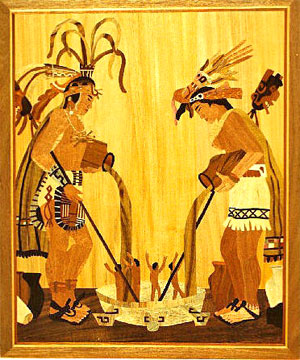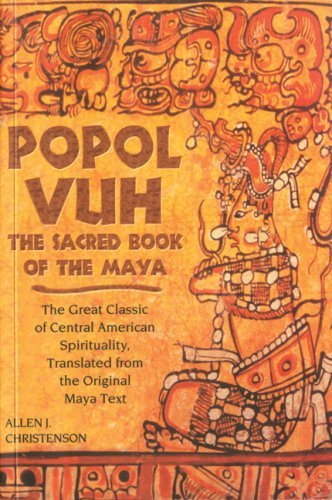Popol Vuh: A Mayan Myth of Creation

Popol Vuh is a chronicle of the Mayan culture that contains the creation myth for the Maya, a culture of people located in Mesoamerica between 300 B.C.E. and 1000 A.D.. Mesoamerica is an area between Mexico and Honduras and Costa Rica, and is made up of a diverse landscape ranging from very tall cold mountains to tropical rain forests in the lower lying regions. The climate is predominantly warm with a moderate amount of rainfall. Due to the rich soil of their land and plentiful rain, the Mayan's always had an excess of food (primarily corn) and were able to then devote their time to other areas of interest. The Mayan's are well known for their astrology chronicles; which could be explained by the high mountain tops in their region, from which they could easily view the heavens, thus allowing them to take records of the night skies.
The Mayan creation myth is accounted for in the Popul Vuh. In the beginning the god's came together to create the earth, next they created animals whom were ordered to name the gods and praise them, but they could not. So the animals were banished to the forests. The first attempt to create humans, they used mud, but these humans spoke only "senselessly" and quickly dissolved in water. Because this human could not walk or procreate, they dismantled this attempt also saying, "let it be merely a thought." In the next attempt to create humans the god's used wood, but these humans were silent and emotionless so the god's destroyed them. Finally the god's used maize to create the humans, "their flesh was made of white and yellow corn." It is because of this that the Mayan's held corn in such a high regard, not only was in the foundation of their diet, but they believed they came from it as well.

When comparing the Mayan creation myth to the Greek classic creation myth, there are very few similarities. Greek creation tells the story of not just how the earth was created, but also the heavens, and focuses on the creation of the gods themselves. In the Mayan creation myth, the gods attempt to create a race of humans to do little more than worship them. Both stories chronicle a trial and error attempt and many tribulations. Both cultures paint a story that creating the world and its inhabitants was not an easy task, and should not be viewed lightly. Due to the great lengths the gods went to in order to create the earth, the earth is meant to be honored and taken care of by its inhabitants. Because of the care and time that the gods put into creating the earth, in both culture's myths', its inhabitants should take great pride in their land, and hold the earth in the highest of regards.
Overall, there are very few parallels between the two culture's stories of creation. While both culture's myths' tell tales of the difficulties in creating the earths inhabitants, they face very different challenges in completing this task. In the Mayan creation story, the god's are faced with a challenge in creating a race of humans that can live and breath, walk and talk, think and feel, and worship the gods. The Greek creation myth tells the story of the trials of the god's child birthing of children that are suitable and will not overthrow their parents. While every culture accounts for the creation of the world as they knew it, there are few similarities between the different culture's stories. However, it does seem that there is a commonality between them all that the earth should be cared for and respected, which the older cultures certainly did.
© 2009 Cara Noelle Guzman








